Recent Progress in Organic Optoelectronic Synaptic Devices
Abstract
1. Introduction
1.1. Memristor Presentation
1.2. Photoelectric Synapses
1.3. Organic Photoelectric Synapse (OPS)
2. Basic Concepts of Organic Photoelectric Synapses and Their Classification
2.1. Photodiode
2.2. Phototransistors
3. Types of Organic Materials Used in Photonic Synaptic Devices
3.1. Small-Molecule Organic Semiconductors
3.2. Conjugated Polymer Semiconductors
4. Mechanism of Operation of Organic Photoelectric Synapses
4.1. Organic Ferroelectric/Electret-like Synaptic Devices
4.2. Heterojunction-like Synapses
4.3. Schottky Barrier Synaptic Devices
4.4. Trap-Modulated Synaptic Devices
4.5. Electrolyte-Gated Layer-like Synaptic Devices
4.6. Photonically Modulated Electrochemically Doped Synapse-like Devices
5. Performance Metrics
5.1. Transition from STP to LTP
5.2. Learning Memory Behavior Simulation
6. Advances in the Application of Organic Photoelectric Synapses
6.1. Imaging Memory: Mimicry of the Visual System
6.2. Sensing Function: Motion Sensing
6.3. Harm Receptors
7. Conclusions and Outlook
Author Contributions
Funding
Institutional Review Board Statement
Informed Consent Statement
Data Availability Statement
Conflicts of Interest
References
- Zidan, M.A.; Strachan, J.P. The future of electronics based on memristive systems. Nat. Electron. 2018, 1, 22–29. [Google Scholar] [CrossRef]
- Van, B.Y.; Melianas, A. Organic electronics for neuromorphic computing. Nat. Electron. 2018, 1, 386–397. [Google Scholar]
- Tang, Y.; Nyengaard, J.R. Total regional and global number of synapses in the human brain neocortex. Synapse 2001, 41, 258–273. [Google Scholar] [CrossRef] [PubMed]
- Alibart, F.; Pleutin, S. An organic nanoparticle transistor behaving as a biological spiking synapse. Adv. Funct. Mater. 2010, 20, 330–337. [Google Scholar] [CrossRef]
- Lai, Q.X.; Zhang, L. Ionic/Electronic hybrid materials integrated in a synaptic transistor with signal processing and learning functions. Adv. Mater. 2010, 22, 2448–2453. [Google Scholar] [CrossRef] [PubMed]
- Ohno, T.; Hasegawa, T. Short-term plasticity and long-term potentiation mimicked in single inorganic synapses. Nat. Mater. 2011, 10, 591–595. [Google Scholar] [CrossRef]
- Josberger, E.E.; Deng, Y.X. Two-terminal protonic devices with synaptic-like short-term depression and device memory. Adv. Mater. 2014, 26, 4986–4990. [Google Scholar] [CrossRef]
- Yang, J.Q.; Wang, R. Neuromorphic Engineering: Neuromorphic Engineering: From Biological to Spike-Based Hardware Nervous Systems. Adv. Mater. 2020, 32, 2070392. [Google Scholar] [CrossRef]
- Choi, S.; Yang, J. Emerging memristive artificial synapses and neurons for energy-efficient neuromorphic computing. Adv. Mater. 2020, 32, 2004659. [Google Scholar] [CrossRef]
- Qi, J.; Li, C. Stability of delayed memristive neural networks with time-varying impulses. Cogn. Neurodyn. 2014, 8, 429–436. [Google Scholar] [CrossRef]
- Indiveri, G.; Chicca, E. A VLSI array of low-power spiking neurons and bistable synapses with spike-timing dependent plasticity. IEEE Trans. Neural Netw. 2006, 17, 211–221. [Google Scholar] [CrossRef] [PubMed]
- Rachmuth, G.; Poon, C.S. Transistor analoguesgs of emergent iono-neuronal dynamics. HFSP J. 2008, 2, 156–166. [Google Scholar] [CrossRef] [PubMed]
- Liu, Y.H.; Zhu, L.Q. Freestanding artificial synapses based on laterally proton-coupled transistors on chitosan membranes. Adv. Mater. 2015, 27, 5599–5604. [Google Scholar] [CrossRef]
- Lont, J.B.; Guggenbuhl, W. CMOS implementation of a multilayer perceptron with nonlinear synapses. IEEE Trans. Neural Netw. 1992, 3, 457–465. [Google Scholar] [CrossRef]
- Strukov, D.B.; Snider, G.S. The missing memristor found. Nature 2008, 453, 80–83. [Google Scholar] [CrossRef]
- Münchenberger, J.; Reiss, G.; Thomas, A. A memristor based on current-induced domain-wall motion in a nanostructured giant magnetoresistance device. J. Appl. Phys. 2012, 111, 07D303. [Google Scholar] [CrossRef]
- He, W.; Huang, K.J. Enabling an integrated rate-temporal learning scheme on memristor. Sci. Rep. 2014, 4, 4755. [Google Scholar] [CrossRef] [PubMed]
- Li, Y.; Zhong, Y.P. Activity-dependent synaptic plasticity of a chalcogenide electronic synapse for neuromorphic systems. Sci. Rep. 2014, 4, 4906. [Google Scholar] [CrossRef]
- Zhang, Q.; Jin, T. Organic field effect transistor-based photonic synapses: Materials, devices, and applications. Adv. Funct. Mater. 2021, 31, 2106151. [Google Scholar] [CrossRef]
- Yi, W.; Tsang, K.K. Biological plausibility and stochasticity in scalable VO2 active memristor neurons. Nat. Commun. 2018, 9, 4661. [Google Scholar] [CrossRef]
- Oh, S.; Shi, Y. Energy-efficient Mott activation neuron for full-hardware implementation of neural networks. Nat. Nanotechnol. 2021, 16, 680–687. [Google Scholar] [CrossRef] [PubMed]
- Boyn, S.; Grollier, J. Learning through ferroelectric domain dynamics insolid-state synapses. Nat. Commun. 2017, 8, 14736. [Google Scholar] [CrossRef] [PubMed]
- Shi, J.; Ha, S.D. A correlated nickelate synaptic transistor. Nat. Commun. 2013, 4, 2676. [Google Scholar] [CrossRef]
- Mou, X.; Tang, J. Analogueg memristive synapse based on topotactic phase transition for high-performance neuromorphic computing and neural network pruning. Sci. Adv. 2011, 7, eabh0648. [Google Scholar] [CrossRef]
- Zhang, H.T.; Park, T.J. Perovskite neural trees. Nat. Commun. 2020, 11, 2245. [Google Scholar] [CrossRef]
- Ryu, H.; Kim, S. Implementation of a reservoir computing system using the short-term effects of Pt/HfO2/TaOx/TiN memristors with self-rectification. Chaos Solitons Fractals 2021, 150, 111223. [Google Scholar] [CrossRef]
- Xu, R.; Jang, H. Vertical MoS2 double-layer memristor with electrochemical metallization as an atomic-scale synapse with switching thresholds approaching 100 mV. Nano Lett. 2019, 19, 2411–2417. [Google Scholar] [CrossRef] [PubMed]
- Bessonov, A.A.; Kirikova, M.N. Layered memristive and memcapacitive switches for printable electronics. Nat. Mater. 2015, 14, 199–204. [Google Scholar] [CrossRef]
- Zhang, F.; Zhang, H. Electric-field induced structural transition in vertical MoTe2- and Mo1–xWxTe2-based resistive memories. Nat. Mater. 2019, 18, 55–61. [Google Scholar] [CrossRef]
- Seo, S.; Jo, S.H. Artificial optic–neural synapse for colored and color-mixed pattern recognition. Nat. Commun. 2018, 9, 5106. [Google Scholar] [CrossRef]
- Shi, Y.; Yuan, B. Electronic synapses made of layered two-dimensional materials. Nat. Electron. 2018, 1, 458–465. [Google Scholar] [CrossRef]
- Sharbati, M.T.; Du, Y. Low-power, electrochemically tunable graphene synapses for neuromorphic computing. Adv. Mater. 2018, 30, 1802353. [Google Scholar] [CrossRef]
- Kireev, D.; Liu, S. Metaplastic and energy-efficient biocompatible graphene artificial synaptic transistors for enhanced accuracy neuromorphic computing. Nat. Commun. 2022, 13, 4386. [Google Scholar] [CrossRef] [PubMed]
- Abdollahramezani, S.; Hemmatyar, O. Electrically driven reprogrammable phase-change metasurface reaching 80% efficiency. Nat. Commun. 2022, 13, 1696. [Google Scholar] [CrossRef]
- Raifuku, I.; Chao, Y.P. Halide perovskite for low-power consumption neuromorphic devices. EcoMat 2021, 3, 12142. [Google Scholar] [CrossRef]
- Hao, D.; Yang, Z. Recent developments of optoelectronic synaptic devices based on metal halide perovskites. Adv. Funct. Mater. 2023, 33, 2211467. [Google Scholar] [CrossRef]
- Hong, X.; Liu, X. Review on metal halide perovskite-based optoelectronic synapses. Photon. Res. 2023, 11, 787–807. [Google Scholar] [CrossRef]
- Satapathi, S.; Raj, K. Halide-perovskite-based memristor devices and their application in neuromorphic computing. Phys. Rev. Appl. 2022, 18, 017001. [Google Scholar] [CrossRef]
- Chen, S.; Huang, J. Recent advances in synaptic devices based on halide perovskite. ACS Appl. Electron. Mater. 2020, 2, 1815–1825. [Google Scholar] [CrossRef]
- Chae, K.; Lee, S.; Phung, T.Q. Mechanical failures of Two-Dimensional materials on polymer substrates. Appl. Surf. Sci. 2022, 605, 154736. [Google Scholar] [CrossRef]
- Wang, J.; Liang, X.; Xie, J. Complete Solution-Processed Semitransparent and Flexible Organic Solar Cells: A Success of Polyimide/Ag-Nanowires-and PH1000-Based Electrodes with Plasmonic Enhanced Light Absorption. Nanomaterials 2022, 12, 3987. [Google Scholar] [CrossRef]
- Li, W.; Guo, F. Solution-processed wide-bandgap organic semiconductor nanostructures arrays for nonvolatile organic field-effect transistor memory. Small 2018, 14, 1701437. [Google Scholar] [CrossRef] [PubMed]
- Yu, X.; Zhang, H. Highly stretchable, ultra-soft, and fast self-healable conductive hydrogels based on polyaniline nanoparticles for sensitive flexible sensors. Adv. Funct. Mater. 2022, 32, 2204366. [Google Scholar] [CrossRef]
- Wang, K.; Dai, S. Light-stimulated synaptic transistors fabricated by a facile solution process based on inorganic perovskite quantum dots and organic semiconductors. Small 2019, 15, 1900010. [Google Scholar] [CrossRef] [PubMed]
- Zhang, H.; Guo, X. Interface engineering of semiconductor/dielectric heterojunctions toward functional organic thin-film transistors. Nano Lett. 2011, 11, 4939–4946. [Google Scholar] [CrossRef] [PubMed]
- Niu, H.; Zhang, H. Micro-nano processing of active layers in flexible tactile sensors via template methods: A review. Small 2021, 17, 2100804. [Google Scholar] [CrossRef]
- Lee, Y.; Lee, T.W. Organic synapses for neuromorphic electronics: From brain-inspired computing to sensorimotor nervetronics. Acc. Chem. Res. 2019, 52, 964–974. [Google Scholar] [CrossRef]
- Xu, W.; Min, S.Y. Organic core-sheath nanowire artificial synapses with femtojoule energy consumption. Sci. Adv. 2016, 2, e1501326. [Google Scholar] [CrossRef]
- Wang, X.; Lu, Y. Highly sensitive artificial visual array using transistors based on porphyrins and semiconductors. Small 2021, 17, 2005491. [Google Scholar] [CrossRef]
- Leydecker, T.; Herder, M. Flexible nonnon-volatile optical memory thin-film transistor device with over 256 distinct levels based on an organic bicomponent blend. Nat. Nanotechnol. 2016, 11, 769–775. [Google Scholar] [CrossRef]
- Lee, C.; Lee, S. A reconfigurable binary/ternary logic conversion-in-memory based on drain-aligned floating-gate heterojunction transistors. Nat. Commun. 2023, 14, 3757. [Google Scholar] [CrossRef] [PubMed]
- Sarkar, T.; Lieberth, K. An organic artificial spiking neuron for in situneuromorphic sensing and biointerfacing. Nat. Electron. 2022, 5, 774–783. [Google Scholar] [CrossRef]
- Harikesh, P.C.; Yang, C.Y. Ion-tunable antiambipolarity in mixed ion–electron conducting polymers enables biorealistic organic electrochemical neurons. Nat. Mater. 2023, 22, 242–248. [Google Scholar] [CrossRef]
- Hou, Y.X.; Li, Y. Large-scale and flexible optical synapses for neuromorphic computing and integrated visible information sensing memory processing. ACS Nano 2020, 15, 1497–1508. [Google Scholar] [CrossRef] [PubMed]
- Hua, Z.; Yang, B. Monolayer molecular crystals for low-energy consumption optical synaptic transistors. Nano Res. 2022, 15, 7639–7645. [Google Scholar] [CrossRef]
- Dai, S.; Zhao, Y. Recent advances in transistor-based artificial synapses. Adv. Funct. Mater. 2019, 29, 1903700. [Google Scholar] [CrossRef]
- Chiang, Y.C.; Hung, C.C. High-performance nonvolatile organic photonic transistor memory devices using conjugated rod–coil materials as a floating gate. Adv. Mater. 2020, 32, 2002638. [Google Scholar] [CrossRef]
- Liu, G.; Li, Q.; Shi, W. Ultralow-power and multisensory artificial synapse based on electrolyte-gated vertical organic transistors. Adv. Funct. Mater. 2022, 32, 2200959. [Google Scholar] [CrossRef]
- Liu, G.; Wen, W.; Zhao, Z. Bionic tactile-gustatory receptor for object identification based on all-polymer electrochemical transistor. Adv. Mater. 2023, 35, 2300242. [Google Scholar] [CrossRef]
- Zhang, Z.D.; Zhong, Y.N. Soft memtransistor with ion transfer interface. Flex. Print. Electron. 2022, 7, 014015. [Google Scholar] [CrossRef]
- Mao, J.Y.; Hu, L. Artificial synapses emulated through a light mediated organic–inorganic hybrid transistor. J. Mater. Chem. C 2019, 7, 48–59. [Google Scholar] [CrossRef]
- Dai, S.; Wu, X. Light-stimulated synaptic devices utilizing interfacial effect of organic field-effect transistors. ACS Appl. Mater. Interfaces 2018, 10, 21472–21480. [Google Scholar] [CrossRef]
- Pu, X.; Shu, F.; Wang, Q. Visual synapse based on reconfigurable organic photovoltaic cell. J. Semicond. 2025, 46, 022403. [Google Scholar] [CrossRef]
- Chen, K.; Hu, H. Organic optoelectronic synapse based on photon-modulated electrochemical doping. Nat. Photonics 2023, 17, 629–637. [Google Scholar] [CrossRef]
- Park, H.L.; Choi, M. Flexible transparent memory systems based on solution-processed organic memristors. J. Korean Phys. Soc. 2022, 81, 285–289. [Google Scholar] [CrossRef]
- Wang, H.; Zhao, Q. A ferroelectric/electrochemical modulated organic synapse for ultraflexible, artificial visual-perception system. Adv. Mater. 2018, 30, 1803961. [Google Scholar] [CrossRef]
- Yang, B.; Lu, Y. Bioinspired multifunctional organic transistors based on natural chlorophyll/organic semiconductors. Adv. Mater. 2020, 32, 2001227. [Google Scholar] [CrossRef] [PubMed]
- Wang, C.; Zhang, X. Organic photodiodes and phototransistors toward infrared detection: Materials, devices, and applications. Chem. Soc. Rev. 2020, 49, 653–670. [Google Scholar] [CrossRef]
- Rim, Y.S.; Yang, Y. Ultrahigh and broad spectral photodetectivity of an organic–inorganic hybrid phototransistor for flexible electronics. Adv. Mater. 2015, 27, 6885–6891. [Google Scholar] [CrossRef]
- Zhang, J.; Shi, Q. Spectrum-dependent photonic synapses based on 2D imine polymers for power-efficient neuromorphic computing. InfoMat 2021, 3, 904–916. [Google Scholar] [CrossRef]
- Lin, Y.C.; Yang, W.C. Recent advances in organic phototransistors: Nonvolatile memory, artificial synapses, and photodetectors. Small Sci. 2022, 2, 2100109. [Google Scholar] [CrossRef]
- Kim, Y.; Zhu, A. A hemispherical image sensor array fabricated with organic photomemory transistors. Adv. Mater. 2023, 35, 2203541. [Google Scholar] [CrossRef]
- Wang, S.; Ryan, J.W. Encapsulation of MEH-PPV: PCBM hybrids in the cores of block copolymer micellar assemblies: Photoinduced electron transfer in a nanoscale donor–acceptor system. Langmuir 2016, 32, 329–337. [Google Scholar] [CrossRef]
- Zhu, M.; Meng, K. Lateral photovoltaic effect in ITO/PEDOT: PSS/MEH-PPV: PCBM/Al organic photovoltaic cells. Org. Electron. 2020, 78, 105585. [Google Scholar] [CrossRef]
- Wu, Y.; Dai, S. Optical Microlithography of Perovskite Quantum Dots/Organic Semiconductor Heterojunctions for Neuromorphic Photosensors. Adv. Funct. Mater. 2024, 34, 2315175. [Google Scholar] [CrossRef]
- Yang, C.; Qian, J. An optically modulated organic Schottky-barrier planar-diode-based artificial synapse. Adv. Opt. Mater. 2020, 8, 2000153. [Google Scholar] [CrossRef]
- Pei, K.; Ren, X. A high-performance optical memory array based on inhomogeneity of organic semiconductors. Adv. Mater. 2018, 30, 1706647. [Google Scholar] [CrossRef]
- Choi, Y.; Ho, D.H. Physically defined long-term and short-term synapses for the development of reconfigurable analogueg-type operators capable of performing health care tasks. Sci. Adv. 2023, 9, 5946. [Google Scholar] [CrossRef]
- Wang, S.; Chen, C. A MoS2/PTCDA hybrid heterojunction synapse with efficient photoelectric dual modulation and versatility. Adv. Mater. 2019, 31, 1806227. [Google Scholar] [CrossRef]
- Qian, C.; Oh, S. Solar-stimulated optoelectronic synapse based on organic heterojunction with linearly potentiated synaptic weight for neuromorphic computing. Nano Energy 2019, 66, 104095. [Google Scholar] [CrossRef]
- Deng, Z.; Zhou, B. Recent progresses of organic photonic synaptic transistors. Flex. Print. Electron. 2022, 7, 024002. [Google Scholar] [CrossRef]
- Abbott, L.F.; Regehr, W.G. Synaptic computation. Nature 2004, 431, 796–803. [Google Scholar] [CrossRef]
- Kim, M.K.; Lee, J.S. Synergistic improvement of long-term plasticity in photonic synapses using ferroelectric polarization in hafnia-based oxide-semiconductor transistors. Adv. Mater. 2020, 32, 1907826. [Google Scholar] [CrossRef]
- Deng, W.; Zhang, X. Organic molecular crystal-based photosynaptic devices for an artificial visual-perception system. NPG Asia Mater. 2019, 11, 77. [Google Scholar] [CrossRef]
- Shi, J.; Jie, J. A fully solution-printed photosynaptic transistor array with ultralow energy consumption for artificial-vision neural networks. Adv. Mater. 2022, 34, 2200380. [Google Scholar] [CrossRef]
- Yokota, T.; Nakamura, T. A conformable imager for biometric authentication and vital sign measurement. Nat. Electron. 2020, 3, 113–121. [Google Scholar] [CrossRef]
- Liu, W.; Chen, W.; Jin, C. Organic optoelectrical synaptic transistors for color information processing. Appl. Phys. Lett. 2023, 123, 193703. [Google Scholar]
- Kumar, M.; Kim, H.S. A highly transparent artificial photonic nociceptor. Adv. Mater. 2019, 31, 1900021. [Google Scholar] [CrossRef]
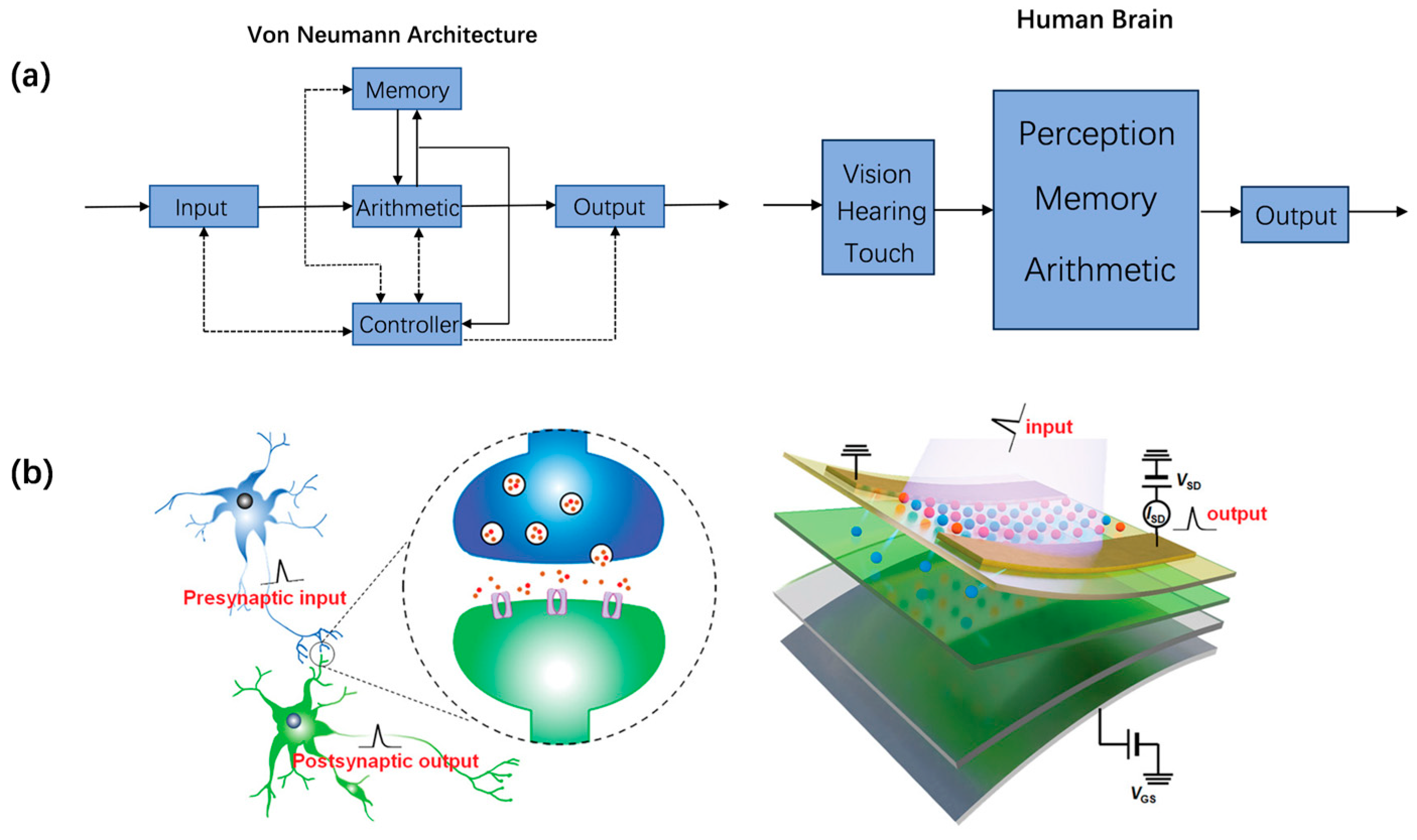
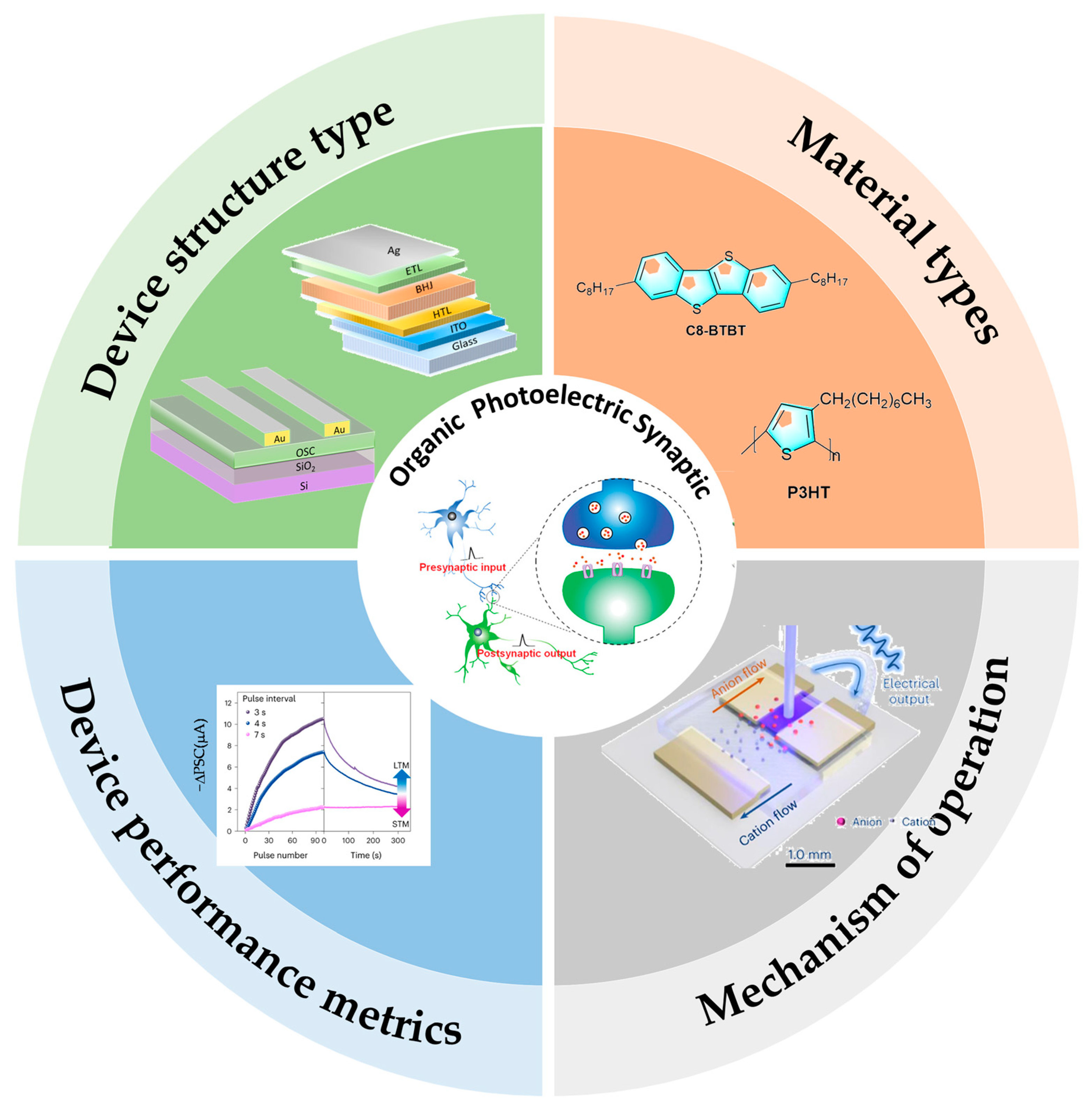


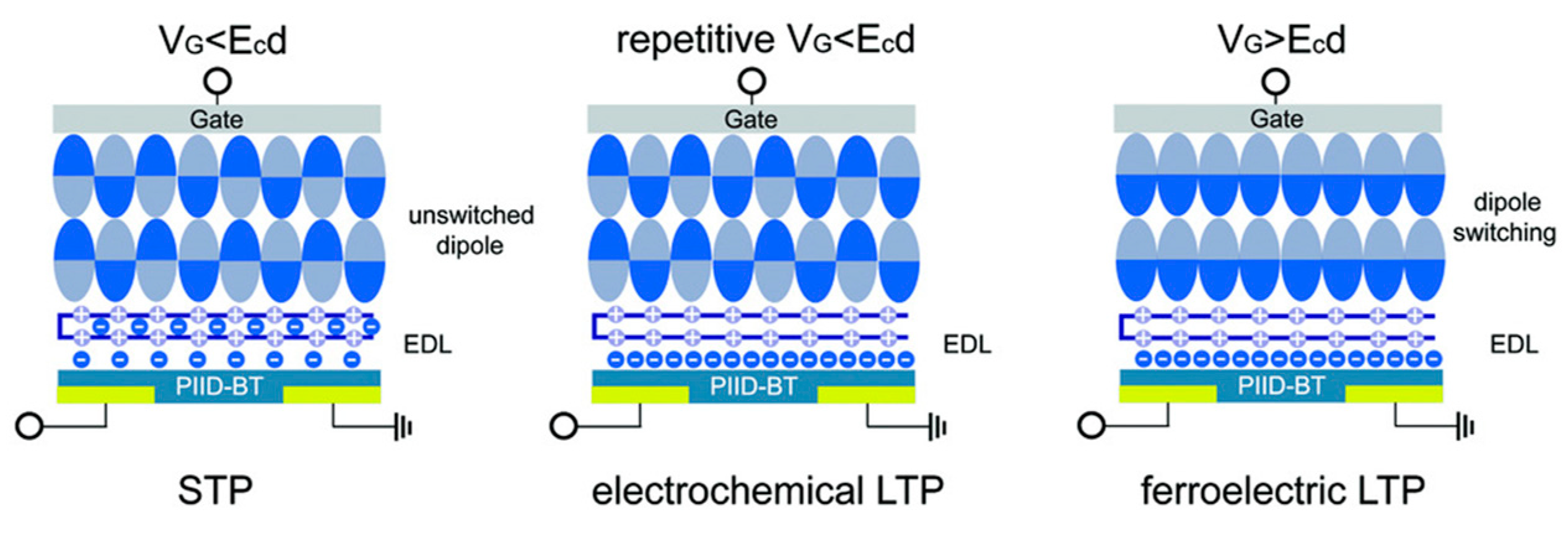



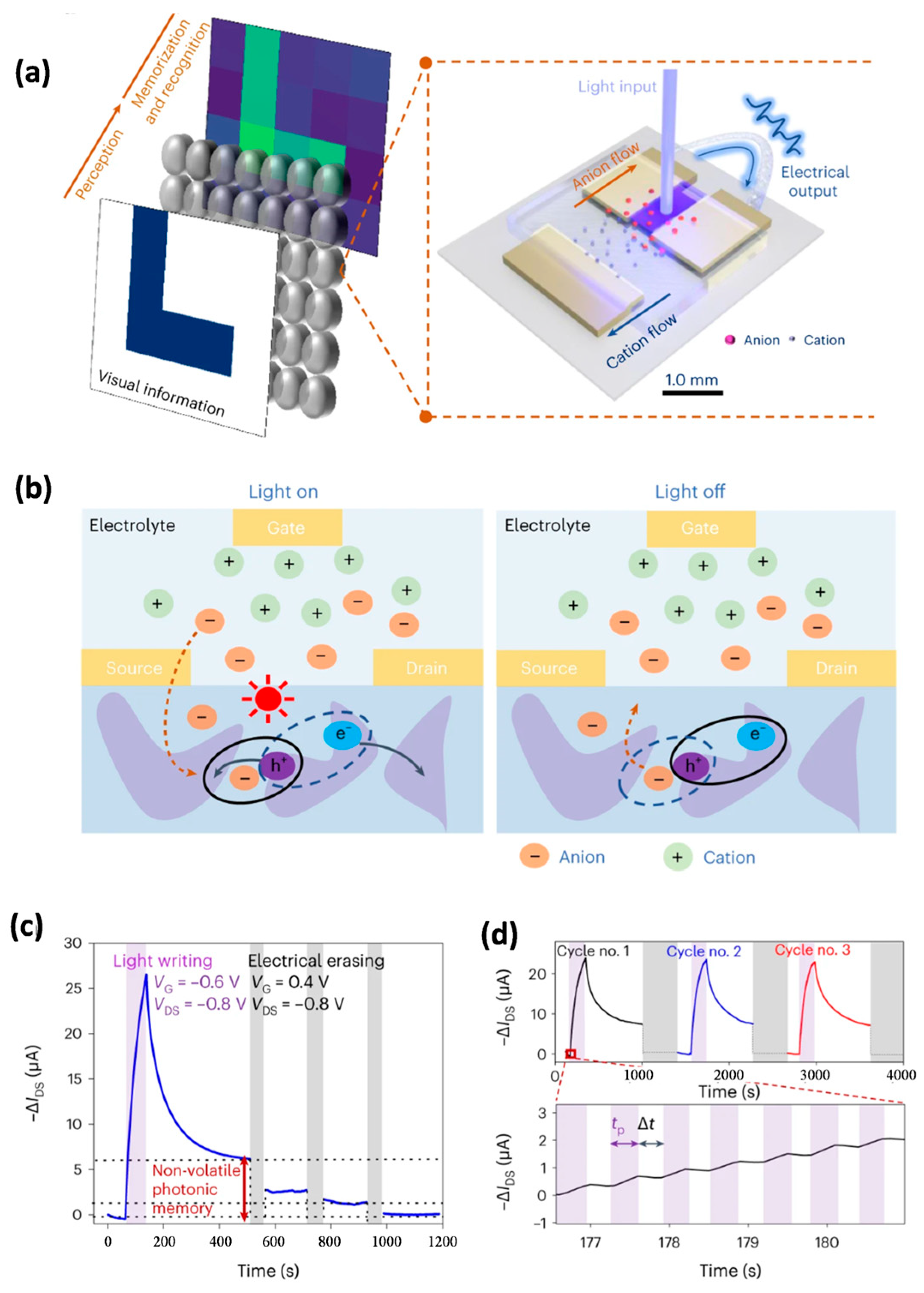




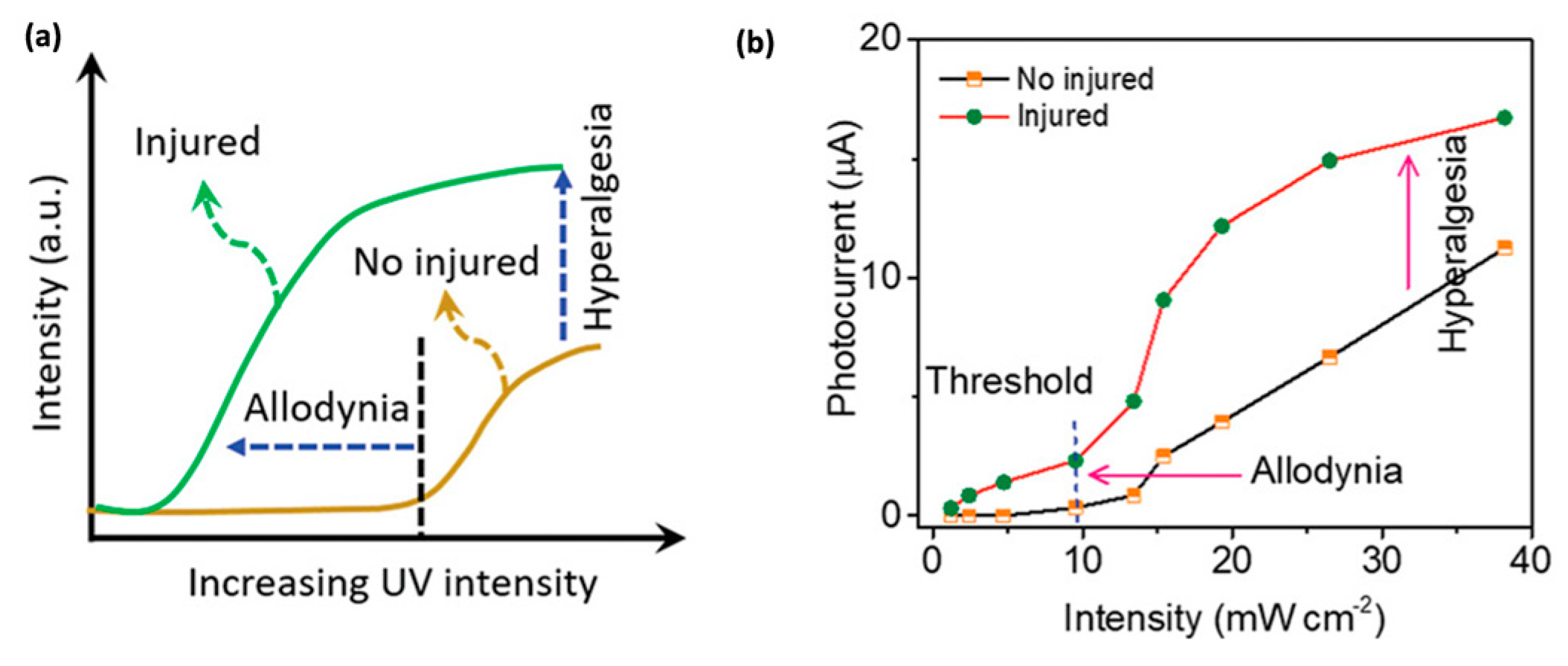
Disclaimer/Publisher’s Note: The statements, opinions and data contained in all publications are solely those of the individual author(s) and contributor(s) and not of MDPI and/or the editor(s). MDPI and/or the editor(s) disclaim responsibility for any injury to people or property resulting from any ideas, methods, instructions or products referred to in the content. |
© 2025 by the authors. Licensee MDPI, Basel, Switzerland. This article is an open access article distributed under the terms and conditions of the Creative Commons Attribution (CC BY) license (https://creativecommons.org/licenses/by/4.0/).
Share and Cite
He, M.; Tang, X. Recent Progress in Organic Optoelectronic Synaptic Devices. Photonics 2025, 12, 435. https://doi.org/10.3390/photonics12050435
He M, Tang X. Recent Progress in Organic Optoelectronic Synaptic Devices. Photonics. 2025; 12(5):435. https://doi.org/10.3390/photonics12050435
Chicago/Turabian StyleHe, Min, and Xin Tang. 2025. "Recent Progress in Organic Optoelectronic Synaptic Devices" Photonics 12, no. 5: 435. https://doi.org/10.3390/photonics12050435
APA StyleHe, M., & Tang, X. (2025). Recent Progress in Organic Optoelectronic Synaptic Devices. Photonics, 12(5), 435. https://doi.org/10.3390/photonics12050435




